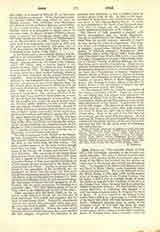

Cork, SCHOOL OF.—The monastic School of Cork had a wide reputation, especially in the seventh and eighth centuries. The name is derived from the Irish corcagh, which means a marsh, for in ancient times the floods of the River Lee covered the low ground on which most of the present city of Cork was afterwards built. The founder of the School and Diocese of Cork was Barra or Bairre (Barry), more commonly called Finbarr the Fair-haired. His family belonged to the Hy Brinin Ratha, a tribe that dwelt on the eastern shore of Lough Corrib, in the County Galway; but his father, a skillful cerd, or certified worker in brass, was forced to migrate to Hy Liathain, in the West of the County Cork, where the saint was born about the middle of the sixth century. His chief teacher was a certain Mac Cuirp, or Curporius, who himself, it is said, had been a student under St. Gregory the Great in Rome. To perfect himself in the science of the saints, Barra retired to a hermitage in a small island of the lonely lake which still bears his name, Gougane Barra. Callanan’s splendid poem in praise of the romantic beauty of this lake has made its name familiar to all Irishmen. From Gougane Barra, it would appear, Barra returned to his native territory, where he founded some dozen churches before he finally established himself near the marsh of Lough Eire (Eirce), which appears to have been the original name of the place. There he founded a monastic school about 620, which in a short time attracted a multitude of students and produced many great scholars. The Irish “Life of Finbarr” gives the names of a dozen of these holy and learned men, who in turn became founders of churches and schools in the South of Ireland. The most distinguished of them was St. Colman Mac Ua Cluasaigh, Ferlegind or professor in the School of Cork about the year 664.
At that time all Ireland was devastated by a terrible yellow plague which carried off two-thirds of the population. There was a prevalent idea that the pestilence could not, or at least did not, extend beyond nine waves from the shore. So Colman and his pupils wisely resolved to migrate from their monastery in the marshes of Cork to one of the islands in the high sea. Being a poet and a holy man he composed a poem, mostly in Irish, committing himself and his pupils to the protection of God and His saints, especially the patron saints of Erin. As they sought their island refuge the students chanted the poem verse by verse, each one reciting his own stanza until it was finished, and then they began again. Fortunately most of this poem still survives, and is printed in the “Leabhar Imuin or “Book of Hymms” (edited by J. H. Todd, Dublin, 1855-69). The language is of the most archaic Gaelic, and is interspersed here and there with phrases mostly taken from Scripture, but made to rhyme with each other as the Gaelic lines themselves do. The School of Cork continued to flourish for many centuries, even after the Danes had established themselves there; in 874 we find recorded the death of a “Scribe of Cork”, and in 891 we are told of the death of a certain son of Connudh, “a scribe, wise man, bishop and abbot of Cork”. In 1134 the ancient monastery and School of Cork, which had fallen into decay, were refounded by the celebrated Cormac MacCarthy, King of Munster. (See Finbarr, Saint.)
JOHN HEALY

